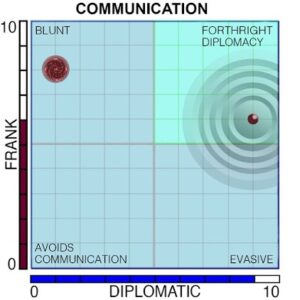I have recently started using the Harrison Assessment system in my work because it is such an insightful and useful tool that can be used in several different ways. Its flexibility, accuracy and how it facilitates analysis is a powerful asset in my work. It was created by Dr Dan Harrison, Ph.D Organisational Psychology, drawing on his background in Mathematics, Personality Theory, Counselling Psychology and Organisational Psychology. It is used by many organisations, including Philips, Dominos and Cathay Pacific.
The two principles it is based on is Enjoyment Performance Theory and Paradox Theory. The first describes how an individual will perform more effectively in a job if they enjoy the tasks required by that job.
Paradox Theory describes how two seemingly contradictory traits are, in fact complementary. The person who is strong in both traits has psychologically resolved the paradox and is balanced in both. They have a greater range of behaviour and are more effective as a result. A person who favours one over the other creates an imbalance which produces stress behaviours when under pressure. The Harrison system has identified 175 traits and 24 of these are paired to measure an individual’s Paradox profile.
The nature of Paradoxical traits
Paradoxical traits are two traits that may appear to be opposite but are, in fact, synergistic. Together they create a force much greater than the individual traits on their own could create. The Harrison system. There are 12 Paradoxes, each made up of two traits:
- Opinions – How you form and hold opinions, including how you deal with ambiguity.
- Decision Approach – How you use logic and intuition when making decisions.
- Strategic – How you strategically manage risk.
- Self – How you manage self-esteem and self-improvement.
- Motivation – How you deal with self-motivation and stress.
- Driving – How you manage rapport and empathy when managing the performance of others.
- Communication – How you manage directness and tactfulness when communicating with others.
- Innovation – How you approach trying new things and overcoming obstacles.
- Delegation – How you approach self-responsibility and collaboration.
- Power – How you approach helping others and asserting your needs.
- Organisation – How you deal with adaptability and creating organization or structure.
- Strategic Acumen – How you approach opportunities and mindfulness of risk.

Is this Paradoxical Leadership applicable to a VUCA environment? Yes – in fact, it is the most appropriate type of leadership in a VUCA environment as many experienced CEOs and management thinkers will testify:
Strategic agility recognises apparent contradictions, tensions and competing forces. The quality of strategic agility enables a response that is not ‘either/or’ but instead can create a response that can use the advantages of both forces to create synergy.
In the next series of articles, I am going to explore in more detail each of the 12 Paradoxes described above. I will do this in the context of the Energy and Renewable Energy sectors because they are both facing an ever increasing range of challenges many of which are accelerating.
Strategic agility recognises apparent contradictions, tensions and competing forces. The quality of strategic agility enables a response that is not ‘either/or’ but instead can create a response that can use the advantages of both forces to create synergy.

















